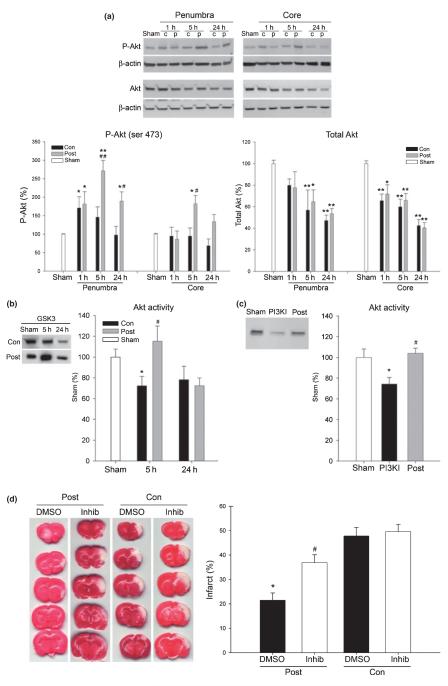Fig. 3.
Akt activity contributed to the protective effect of postconditioning. (a) Changes in phosphorylated-Akt (P-Akt) and total Akt after stroke in rats with and without postconditioning. Representative protein bands for P-Akt (Ser473), total Akt and β-actin in both the ischemic penumbra and the core are shown. Relative optical densities of protein bands in ischemic rats were normalized to those in sham rats and calibrated with β-actin. Postconditioning up-regulated the overall protein level of P-Akt across all time points compared with control ischemia (two-way ANOVA: p = 0.005 in the penumbra, p = 0.027 in the ischemic core). *p < 0.05 and **p < 0.01 versus sham, respectively; #p < 0.01 and ##p < 0.05 versus control at a corresponding time point, respectively. Total Akt decreased after ischemia in both the ischemic core and penumbra; postconditioning had no statistically significant effect. *p < 0.01 and *p < 0.05 versus sham, n = 5–7/group. c, control; p, postconditioning. (b) Postconditioning increased in vitro Akt activity at 5 h. Akt activity as assessed by protein levels of phosphophorylated Akt substrate, a fusion protein of glycogen synthase kinase (GSK3β) is expressed as percentages of phosphorylated GSK3β (P-GSK3) from sham animals. *p < 0.05 versus sham; #p < 0.05 versus 5-h control, n = 5/group. (c) Phosphoinositide 3-kinase (PI3K) inhibitor, LY294002 inhibited Akt activity at 5 h in postconditioned animals. Antibody directed against P-GSK3β was used for detection. *p < 0.05 versus sham; #p < 0.05 versus PI3K inhibitor. (d) The PI3K inhibitor LY294002, partially blocked the protective effect of postconditioning. Infarct size was detected by 2,3,5-triphenyl-2H-tetrazolium chloride (TTC) staining 2 days after stroke. The left columns show representative TTC staining from rat brains that received postconditioning or control ischemia treated with vehicle [dimethylsulfoxide (DMSO)] or with the PI3K inhibitor LY294002. Bar graph (right panel) shows quantitation of the data. *p < 0.001 versus other groups and #p < 0.05 versus DMSO/con and inhib/con. Post, postconditioning; con, control ischemia; inhib, PI3K inhibitor.

